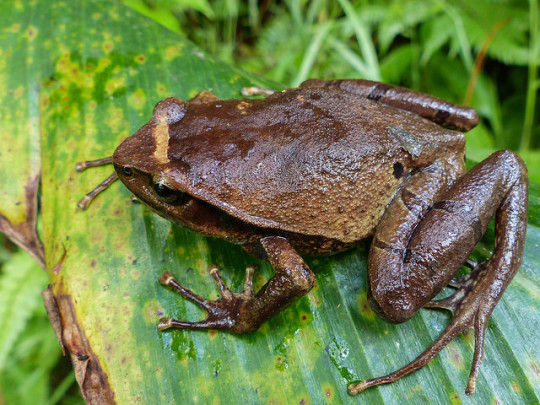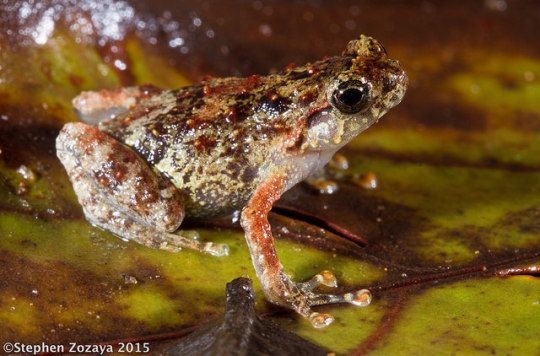#Cophylinae
Video
I spent my day working on describing new species of Rhombophryne, the ‘diamond frogs’ of Madagascar. I’ve been working on these frogs since 2013, and have described more than half of the currently known species, but there are still so many species to describe.
Here, I am working on the second most important part of the description of one new species: the holotype description. This involves very careful examination and description of the features of the one specimen that ‘carries’ the name of the species. As you can see, I talk with myself a lot while I am doing this. I’m noting aloud features that are substantially different from other species, or things that are worth describing. I find this quite the best way to keep the features in my mind while I am looking at a lot of things at once—but of course it only works while I have my office to myself.
The *most* important part of every species description is the diagnosis. This includes the list of features that are the ones that ‘define’ your new species, and in many cases also the way that it can be told apart from all the other relevant species. In the case of the paper I am working on here, that is the last thing I will be doing for each species, as it will depend on having everything described and ready beforehand.
#taxonomy#science#zoology#systematics#amphibians#newspecies#Rhombophryne#Cophylinae#Micrhoylidae#species description#scientist at work#Madagascar#amphibian#wildlife#frog#frogs#new species#long time no post#It was fun to make this#I haven't made one of these timelapses of myself working before
113 notes
·
View notes
Photo

Mini mum lives in the leaf litter along Madagascar’s eastern coast.
New staple-size frog is one of the tiniest ever discovered
“Astronomically small,” the newly discovered Malagasy amphibians have brains that could sit on a pin.
BY MICHELLE Z. DONAHUE
MARCH 27, 2019
HOW MANY WAYS can you say “tiny?” How about miniature, miniscule, and minimum, for starters?
These adjectives not only describe three new species of frog from Madagascar, but also serve as their official scientific names.
Mini mum, Mini ature, and Mini scule “are astronomically small,” says Mark Scherz, an evolutionary biologist at Ludwig-Maximilians Universität in Munich, Germany, who described these and two other new tiny frog species in a new study published March 27 in the journal PLoS ONE. Mini is an all-new genus of frog.
“You could sit the brain on the top of a pin. It’s amazing that they have all the same organs you or I have in our bodies, but in a package that can fit four times on your own thumbnail.”
The smallest, Mini mum, is about the size of a standard paper staple, or about 8 to 10 millimeters long; the largest, Mini ature, measures 14.9 millimeters—about the length of a microSD card. The world's smallest known frog—and vertebrate—is a housefly-size frog that’s about 7.7 millimeters long.
An adult male Mini mum, one of the world’s smallest frogs, rests on a fingernail with room to spare.
Each of the three amphibians exist only in one location in Madagascar. Mini mum in particular has an extremely limited range and known population, prompting the study authors to recommend a listing of critically endangered.
A family of microfrogs
The new frogs are part of an informal group called microfrogs, which belong to the family Cophylinae. Their discovery brings the total number of Malagasy microfrogs to108; on average, 10 new species are identified and described per year in the country.
Scherz and colleagues have found more than 40 microfrogs since they began studying the species in 2014.
Of course, finding a new species is no small feat.
Identifying superficial differences in similar-looking frogs is challenging in a normal-size animal; in microfrogs, it’s virtually impossible. But along with molecular and genetic work, microCT scanning enabled Scherz and team to examine minute differences in the teeth and bones of the various animals, helping make the case that they were indeed unique species.
It’s also not simple finding the animals, which live in the leaf litter of isolated forests in the island’s southeast, and within the dense bases of grass tussocks in the mountainous north. (See amazing photos of Madagascar.)
The frogs likely evolved their tiny stature to take advantage of ecological niches few other creatures can, for instance by hunting equally tiny prey such as ants, termites, and springtails.
What’s in a name?
Jim Hanken, an evolutionary biologist at Harvard who studies miniature South American amphibians, says the new analysis offers good bone, tooth, and molecular evidence to justify the creation of an entirely new genus.
He also appreciates the levity of the frogs’ names, but cautioned that comical names can become confusing—as often happens when animals are regrouped into new families, or it turns out that a chosen name was previously applied to another organism.
That’s what happened with a South American worm salamander originally named Oedipus complex (and its relative, rex), so when it was renamed Oedipina to avoid multiple usage, the original joke fell flat.
“There’s always the risk that when you do this witty stuff, someone will come along and change it,” Hanken says.
Scherz says he chose the names Mini mum, Mini ature, and Mini scule to pique the public’s interest.
“So much about science is dry,” he says. “If there’s anything we can do to make our science more approachable, we should do it.”
0 notes
Photo

Anodonthyla cf. emilei by Stephen Zozaya on Flickr.
#frog#animals#Madagascar#Microhylidae#Cophylinae#Anodonthyla#Anodonthyla emilei#Anodonthyla boulengeri#not sure which of those two it is but the orange on the legs makes me think it might be A. emilei#the two are very very hard to tell apart
188 notes
·
View notes
Text
A swathe of Stumpffia: 26 new species
A swathe of Stumpffia: 26 new species! Read more here:
Stumpffia cf. meikeae, one of the new species described Published today in the open access journal Vertebrate Zoology, Andolalao Rakotoarison and a team of 17 other authors, including yours truly, have described 26 new species of Stumpffia, a genus of small narrow-mouthed frogs endemic to Madagascar! You can access the PDF of this paper here at high resolution (72 MB), and here at low resolution…
View On WordPress
#amphibians#animals#Cophylinae#forest#frogs#herpetology#madagascar#Microhylidae#new species#science#Stumpffia#taxonomy#wildlife
23 notes
·
View notes
Photo

Plethodontohyla inguinalis by Axel Marchelie
157 notes
·
View notes
Photo

Plethodontohyla inguinalis by Stephen Zozaya
96 notes
·
View notes
Photo

Anodonthyla moramora by Stephen Zozaya
134 notes
·
View notes
Photo

Plethodontohyla ocellata by Stephen Zozaya
10 notes
·
View notes
Photo

Platypelis pollicaris by Stephen Zozaya
177 notes
·
View notes